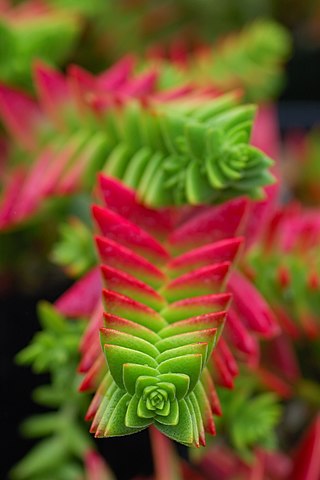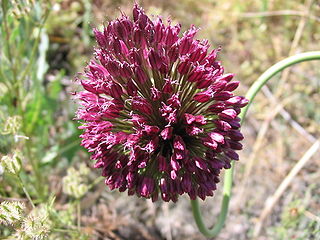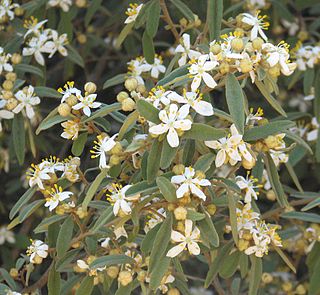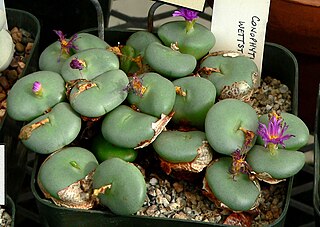
The Rosary, also known as the Dominican Rosary, refers to a set of prayers used primarily in the Catholic Church, and to the physical string of knots or beads used to count the component prayers. When referring to the prayer, the word is usually capitalized ; when referring to the prayer beads as an object, it is written with a lower-case initial letter.

Fuchsia is a genus of flowering plants that consists mostly of shrubs or small trees.

Ceanothus is a genus of about 50–60 species of nitrogen-fixing shrubs and small trees in the buckthorn family (Rhamnaceae). Common names for members of this genus are buckbrush, California lilac, soap bush, or just ceanothus. "Ceanothus" comes from Ancient Greek: κεάνωθος (keanōthos), which was applied by Theophrastus to an Old World plant believed to be Cirsium arvense.

Crassula is a genus of succulent plants containing about 200 accepted species, including the popular jade plant. They are members of the stonecrop family (Crassulaceae) and are native to many parts of the globe, but cultivated varieties originate almost exclusively from species from the Eastern Cape of South Africa.

Allium sphaerocephalon is a plant species in the Amaryllis family known as round-headed leek, round-headed garlic, ball-head onion, and other variations on these names. Drumstick allium is another common name applied to this species. Some publications use the alternate spelling Allium sphaerocephalum. It is a bulbous herbaceous perennial plant.

Lavandula angustifolia, formerly L. officinalis, is a flowering plant in the family Lamiaceae, native to the Mediterranean. Its common names include lavender, true lavender and English lavender ; also garden lavender, common lavender and narrow-leaved lavender.

Ceropegia woodii is a flowering plant in the dogbane family Apocynaceae, native to South Africa, Eswatini and Zimbabwe. It is sometimes treated as a subspecies of the related Ceropegia linearis, as C. linearis subsp. woodii. Common names include chain of hearts, collar of hearts, string of hearts, rosary vine, hearts-on-a-string, and sweetheart vine.

Asterolasia is a genus of seventeen species of erect or prostrate shrubs in the family Rutaceae, and is endemic to Australia. The leaves are simple and arranged alternately, the flowers arranged in umbel-like groups on the ends of branchlets or in leaf axils, usually with five sepals, five petals and ten to twenty-five stamens. There are seventeen species and they are found in all Australian mainland states but not in the Northern Territory.
Crassula colorata, the dense pigmyweed or dense stonecrop, is an annual plant in the family Crassulaceae. The species is endemic to Australia, occurring in Western Australia, South Australia, New South Wales and Victoria.

Cotyledon tomentosa is a species of flowering plant in the family Crassulaceae, native to South Africa. It is a succulent evergreen shrub with large chunky ovate fuzzy green leaves. Its autonymous subspecies is known as the bear's paw because of the prominent "teeth" at the tips of its leaves. It forms large orange bell-shaped flowers in spring. In its native habitat, the Little Karoo region of South Africa, Cotyledons usually grow in rocky quartz fields where they have excellent drainage provided by very porous soil.

Geranium subcaulescens is a species of flowering plant in the geranium family Geraniaceae, that is native to Italy, Turkey and the Balkans. A low, mounded evergreen perennial, it typically grows to 8 in (20 cm) tall by more than 11 in (28 cm) broad, with grey-green orbicular and lobed leaves, and masses of bright magenta pink flowers with black centres in summer.

Crassula marnierana, common name Jade Necklace or Chinese Pagoda, is a species of succulent flowering plant in the family Crassulaceae.

Crassula ovata, commonly known as jade plant, lucky plant, money plant or money tree, is a succulent plant with small pink or white flowers that is native to the KwaZulu-Natal and Eastern Cape provinces of South Africa, and Mozambique; it is common as a houseplant worldwide. Much of its popularity stems from the low levels of care needed; the jade plant requires little water and can survive in most indoor conditions. It is sometimes referred to as the money tree; however, Pachira aquatica also has this nickname.

Crassula pellucida is a creeping, succulent ground-cover, or low-growing, spreading succulent shrub. It is native to eastern and southern Africa, ranging from Kenya and Angola to South Africa.

Crassula perfoliata is the type species of the genus Crassula, in the flowering plant family Crassulaceae, where it is placed in the subfamily Crassuloideae. It was first formally described by Linnaeus in 1753 as one of 10 species of Crassula. It is native to South Africa, Mozambique, Eswatini, and Zimbabwe.

Gordon Douglas Rowley (1921–2019) was a British botanist and writer specialising in cacti and succulents.

Artemisia alba, called white mugwort, white wormwood, white artemisia, or camphor southernwood, is a species of Artemisia native to Spain, France, Belgium, Italy, Sicily, the Czech Republic, Slovakia, Hungary, Romania, and the Balkans. Its currently unrecognized subtaxon Artemisia alba 'Canescens' has gained the Royal Horticultural Society's Award of Garden Merit.

Rhododendron calostrotum is a species of flowering plant in the genus Rhododendron native to Tibet, south-central China, and Myanmar. Its putative subspecies Rhododendron calostrotum subsp. keleticum, called the beautiful-covering rhododendron, and its cultivar 'Gigha' have both gained the Royal Horticultural Society's Award of Garden Merit.

Conophytum wettsteinii is a species of flowering plant in the genus Conophytum, native to the northwest Cape Provinces of South Africa. It is known to grow in rocky regions, often nearby Crassula elegans. C. wettsteinii is a small groundcover species, which appears stemless with fused leaf-pairs having a obconical shape. This plant relies on winter rains and is mainly dormant in summer months. Best growth occurs when drainage is available, and when only shaded during mid-summer. PRopegation can occur through seeds or though cuttings from a full grown plant, where each cutting contains at least 1 head and a fraction of root. It has gained the Royal Horticultural Society's Award of Garden Merit.


















